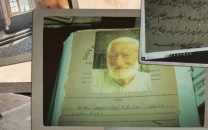SC, LHC judges also get ‘powder-laced’ letters
CJP among recipients; CTD registers case

A day after threatening letters containing a suspicious powdery toxic substance were sent to eight judges of the Islamabad High Court, it emerged on Wednesday that the Supreme Court jurists, including Chief Justice of Pakistan Qazi Faez Isa, as well those of the Lahore High Court had received similar ones too.
Islamabad DIG (Operations) Shahzad Bukhari made the disclosure before IHC Chief Justice Aamer Farooq.
The DIG (Operations), summoned by the IHC CJ during the hearing of the cipher case, informed that four SC judges -- CJP Isa, Justices Athar Minallah, Jamal Khan Mandokhail, and Aminuddin Khan -- had received similar letters on April1.
Additionally, letters were also received by SC’s Justices Mansoor Ali Shah and Shahid Waheed posted by someone identifying themselves as Gulshad Khatun, according to sources.
During the hearing, the DIG Operations informed the court that all the envelopes contained letters as well as the powdery substance and they had been sent to the laboratory for an analysis.
Copies of the letters, suspected to contain anthrax powder, have also been handed over to the Counter-Terrorism Department (CTD) for investigation.
Furthermore, the police department has written to the relevant postmaster general on the issue of the stamps “not being discernible".
The police officer further revealed that LHC judges had also received similar letters.
When questioned by the IHC CJ about the steps taken alongside the analysis of the letters, the DIG Operations replied that it appeared the stamps were from an area in Rawalpindi.
A CTD officer informed the court that the initial investigation indicated that the letters were sent from the General Post Office (GPO) Rawalpindi and dropped into a letterbox.
He added that the senders of the letters to the LHC judges had used various names including Resham and Reshma.
Expressing his dissatisfaction, the IHC chief justice reprimanded the police officers for their failure to properly identify the postal stamps.
The sources revealed that a meeting took place between the CTD team and SC registrar.
A case was registered at the CTD police station on the complaint of SC’s Receipt and Issue Department head Mohammad Iqbal Khan under Section 507 of the Pakistan Penal Code and Section 7 of the Anti-Terrorism Act.
It read that mail was received on March 29 or 30 through the post office. It was dispatched and received by the personal secretaries of the SC judges.
The mail contained four envelopes in the name of the CJP and three other SC judges.
The complainant said the administration in-charge told him on the phone on Wednesday that “a white powder-like chemical” was present in the four letters sent to the CJP as well as those addressed to the three other judges.
He added that three of the letters were sent by Gulshad Khatun from an “unknown address”.
Khan continued that the fourth letter was sent by Sajjad Hussain, who too had an “unknown address”.
The complainant said the two individuals had tried spread “fear and harassment”.
Earlier, a case in connection with the letters received by the IHC judges was also filed with the CTD.
The LHC judges, including the high court’s chief justice Malik Shahzad Ahmad Khan, also received threatening letters on Wednesday, prompting heightened security measures at the court premises to prevent any potential mishaps.
Sources revealed that the LHC staff initially overlooked the letter addressed to the chief justice, dismissing it as routine correspondence.
However, on opening the envelope, it was discovered that the letter contained a suspicious powder, the sources added.
Previously, similar letters were received by LHC senior puisne judge Justice Shujaat Ali Khan as well as Justices Shahid Bilal Hassan, Aalia Neelum, and Abid Aziz Sheikh.
On the discovery of these letters by the court staff on Wednesday, police officials stationed at the LHC were immediately alerted, and a search operation was initiated within the court premises.
A courier company employee was detained for further investigation.
Shortly thereafter, a team comprising the Lahore DIG Operations, CTD additional inspector general, CCPO, Crime Scene Unit, forensic experts, chief secretary, and other officials arrived at the scene to investigate the matter.
A credible source alleged that the letters were dispatched from Islamabad and were sent by an individual named Mohad Fazil, who purportedly threatened judicial officers, military personnel, and politicians.
It was reported that when a police officer opened one of the letters in front of a judge, some powder spilled onto the floor, prompting the jurist to reprimand him for the mistake.
The CTD officer criticised the police officer for the negligence, stating that it violated the standard operating procedures (SOPs).
Speaking to the media, DIG Investigation Ali Nasir Rizvi said an investigation was under way into the matter, emphasising that making premature statements before the conclusion of the probe would be inappropriate.
When asked about the contents of the letters and how they were identified as suspicious, Rizvi explained that the CTD was diligently investigating the matter and could not afford to take any risks without a thorough examination.
A day earlier, the IHC chief justice, along with seven other judges of the high court, received letters suspected to be laced with anthrax.
This incident occurred just after the apex court initiated suo motu proceedings in response to allegations made by the six IHC judges against intelligence agencies.
A police team, including experts, has initiated an investigation to gather evidence and determine the nature of the powdery substance found in the letters received by the eight IHC judges.
The letter, sent by an individual named Resham without a specified address, contained suspected anthrax powder along with a threatening message.
According to the sources, a court staff member inadvertently dropped an envelope containing the suspicious substance, resulting in severe irritation to the eyes and burns on the skin around the lips.
All suspicious letters have been handed over to the police for further investigation.



















COMMENTS
Comments are moderated and generally will be posted if they are on-topic and not abusive.
For more information, please see our Comments FAQ